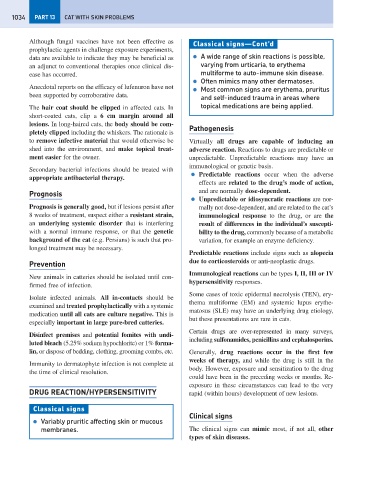Page 1042 - Problem-Based Feline Medicine
P. 1042
1034 PART 13 CAT WITH SKIN PROBLEMS
Although fungal vaccines have not been effective as
Classical signs—Cont’d
prophylactic agents in challenge exposure experiments,
data are available to indicate they may be beneficial as ● A wide range of skin reactions is possible,
an adjunct to conventional therapies once clinical dis- varying from urticaria, to erythema
ease has occurred. multiforme to auto-immune skin disease.
● Often mimics many other dermatoses.
Anecdotal reports on the efficacy of lufenuron have not
● Most common signs are erythema, pruritus
been supported by corroborative data.
and self-induced trauma in areas where
The hair coat should be clipped in affected cats. In topical medications are being applied.
short-coated cats, clip a 6 cm margin around all
lesions. In long-haired cats, the body should be com-
Pathogenesis
pletely clipped including the whiskers. The rationale is
to remove infective material that would otherwise be Virtually all drugs are capable of inducing an
shed into the environment, and make topical treat- adverse reaction. Reactions to drugs are predictable or
ment easier for the owner. unpredictable. Unpredictable reactions may have an
immunological or genetic basis.
Secondary bacterial infections should be treated with
● Predictable reactions occur when the adverse
appropriate antibacterial therapy.
effects are related to the drug’s mode of action,
Prognosis and are normally dose-dependent.
● Unpredictable or idiosyncratic reactions are nor-
Prognosis is generally good, but if lesions persist after mally not dose-dependent, and are related to the cat’s
8 weeks of treatment, suspect either a resistant strain, immunological response to the drug, or are the
an underlying systemic disorder that is interfering result of differences in the individual’s suscepti-
with a normal immune response, or that the genetic bility to the drug, commonly because of a metabolic
background of the cat (e.g. Persians) is such that pro- variation, for example an enzyme deficiency.
longed treatment may be necessary.
Predictable reactions include signs such as alopecia
Prevention due to corticosteroids or anti-neoplastic drugs.
Immunological reactions can be types I, II, III or IV
New animals in catteries should be isolated until con-
hypersensitivity responses.
firmed free of infection.
Some cases of toxic epidermal necrolysis (TEN), ery-
Isolate infected animals. All in-contacts should be
thema multiforme (EM) and systemic lupus erythe-
examined and treated prophylactically with a systemic
matosus (SLE) may have an underlying drug etiology,
medication until all cats are culture negative. This is
but these presentations are rare in cats.
especially important in large pure-bred catteries.
Certain drugs are over-represented in many surveys,
Disinfect premises and potential fomites with undi-
including sulfonamides, penicillins and cephalosporins.
luted bleach (5.25% sodium hypochlorite) or 1% forma-
lin, or dispose of bedding, clothing, grooming combs, etc. Generally, drug reactions occur in the first few
weeks of therapy, and while the drug is still in the
Immunity to dermatophyte infection is not complete at
body. However, exposure and sensitization to the drug
the time of clinical resolution.
could have been in the preceding weeks or months. Re-
exposure in these circumstances can lead to the very
DRUG REACTION/HYPERSENSITIVITY rapid (within hours) development of new lesions.
Classical signs
Clinical signs
● Variably pruritic affecting skin or mucous
membranes. The clinical signs can mimic most, if not all, other
types of skin diseases.

